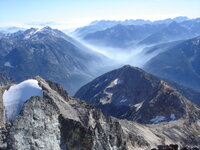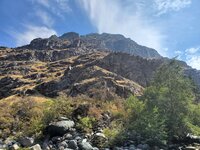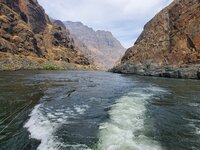The Rockys can be tough and steep. Especially in NW Montana and Parts of Idaho. The nastiest mountains i have hunted are right here in WNC , my home state. These NC mountains are brutal! Straight up in the worst areas with Mtn Laurel Thickets growing all over. Add all kinds of super slick leaves to cause you to slide up and down as well, it makes for some tough hunting. On top of that ,the visibility is usual terrible as well.
Navigation
Install the app
How to install the app on iOS
Follow along with the video below to see how to install our site as a web app on your home screen.
Note: This feature may not be available in some browsers.
More options
Style variation
You are using an out of date browser. It may not display this or other websites correctly.
You should upgrade or use an alternative browser.
You should upgrade or use an alternative browser.
In your experience, where are the biggest, most rugged mountains?
- Thread starter Jbrow327
- Start date
western406
FNG
The Rocky Mountains is the marrow of the world
yfarm
WKR
Hunted the Floridas in January, snakes are gone. Elevation change is not bad. Took me a 66 y/o at the time 2 hrs to get on top from the eastern base, son a marathon runner did it in an hour and a half. Be on top, start down and be in a motel in Deming in under 3 hrs. Yeah there are cliffs but there are more in remote parts of the Absarokas and Wind River. Unfortunately the goats like the highest and steepest part of the Floridas but the hard part is getting to the down animal and packing it out, speaking about the rifle hunt; bow would be a completely different hunt
butcherboy
WKR
The Floridas are a butt kicker. Some parts are easier than others with less cliffs. Just depends on which side you are climbing. I was 16 the first time I was in there on a hunt with my dad. Now, 30 years later, still one of the toughest Mtns I have been on and I’ve been back 3 times hunting it. Everything will poke you, stab you, and bite you. Lots of loose rock and unseen overgrown mine shafts to watch out for. It’s fun as heck to hunt those little goats!
ColeyG
WKR
- Joined
- Oct 25, 2017
- Messages
- 443
Considering the OPs question and criteria, "biggest and most rugged," I think the clear winner would the the North Cascades in Washington.
The volcanoes there start close to sea level and rise to close to 11k (Baker, Glacier Peak) giving the "range" more elevation gain from base to summit that other peaks say in the Tetons, Rockies, etc. So that is how I'd quantify "biggest."
In considering criteria to evaluated "rugged," I think of developed trails, or lack thereof, severity of bushwacking, steepness of terrain, complexity of terrain (rock, snow, ice, elevation gain and loss, river crossings, etc.) I have yet to set foot in a range that I could say, when taken as a whole, that offered a bigg ass beating that the N Cascades. Some corners of the Sierra and places like the Sawtooths, and Absorkas come close, but overall the cross country travel is easier, the climate more fair, and there are more developed trails and routes than the N Cascades.
I mean the place has it's own bushwack rating system for crying out loud:
In his description for a route on the venerable roadside test piece, Mount Index, the legendary Fred Beckey recommended imitating "a gorilla through the brush" to navigate difficulties when approaching the actual hard part, climbing the mountain.




Of course the N Cascades would hardly occupy a small corner of the trailess alpine wilderness that is the Alaska Range, but we aren't allowed to talk about that here.
The volcanoes there start close to sea level and rise to close to 11k (Baker, Glacier Peak) giving the "range" more elevation gain from base to summit that other peaks say in the Tetons, Rockies, etc. So that is how I'd quantify "biggest."
In considering criteria to evaluated "rugged," I think of developed trails, or lack thereof, severity of bushwacking, steepness of terrain, complexity of terrain (rock, snow, ice, elevation gain and loss, river crossings, etc.) I have yet to set foot in a range that I could say, when taken as a whole, that offered a bigg ass beating that the N Cascades. Some corners of the Sierra and places like the Sawtooths, and Absorkas come close, but overall the cross country travel is easier, the climate more fair, and there are more developed trails and routes than the N Cascades.
I mean the place has it's own bushwack rating system for crying out loud:
In his description for a route on the venerable roadside test piece, Mount Index, the legendary Fred Beckey recommended imitating "a gorilla through the brush" to navigate difficulties when approaching the actual hard part, climbing the mountain.




Of course the N Cascades would hardly occupy a small corner of the trailess alpine wilderness that is the Alaska Range, but we aren't allowed to talk about that here.
Some really awesome photos, thanks for sharing.Considering the OPs question and criteria, "biggest and most rugged," I think the clear winner would the the North Cascades in Washington.
The volcanoes there start close to sea level and rise to close to 11k (Baker, Glacier Peak) giving the "range" more elevation gain from base to summit that other peaks say in the Tetons, Rockies, etc. So that is how I'd quantify "biggest."
In considering criteria to evaluated "rugged," I think of developed trails, or lack thereof, severity of bushwacking, steepness of terrain, complexity of terrain (rock, snow, ice, elevation gain and loss, river crossings, etc.) I have yet to set foot in a range that I could say, when taken as a whole, that offered a bigg ass beating that the N Cascades. Some corners of the Sierra and places like the Sawtooths, and Absorkas come close, but overall the cross country travel is easier, the climate more fair, and there are more developed trails and routes than the N Cascades.
I mean the place has it's own bushwack rating system for crying out loud:
In his description for a route on the venerable roadside test piece, Mount Index, the legendary Fred Beckey recommended imitating "a gorilla through the brush" to navigate difficulties when approaching the actual hard part, climbing the mountain.
View attachment 488025
View attachment 488026
View attachment 488027
View attachment 488028
Of course the N Cascades would hardly occupy a small corner of the trailess alpine wilderness that is the Alaska Range, but we aren't allowed to talk about that here.
WV Mountaineer
WKR
Coal fields in West Virginia, south western Virginia, and eastern Kentucky. Over all elevation is low. Less than 4000’. Elevation change isn’t too bad either. Usually 1200’-1500’. It’s the 75-80% slopes that gets you. From the creek to the spine. No benches. Just straight the frigg up. If it weren’t for the laurel and rhododendron to hold on to, it’d be impossible to ever climb them without climbing gear. Don’t fall either. You are going to stop when you hit the creek.
jayhawk
WKR
- Joined
- Apr 2, 2022
- Messages
- 537
"In the USA, but outside of Alaska" actually makes sense....Lots of people apparently need a geography lesson!
"In the USA, but outside of Alaska...*
West Virginia is the most rugged state I've ever visited. Not a straight road or flat piece of ground in the place. Nothing to do with hunting, but fun fact is most cross-country bicyclists ride west to east because the Rockies are much easier to cross than the Appalachians. By the time they get to Eastern KY, they're in much better condition.
SwiftShot
WKR
- Joined
- Nov 16, 2019
- Messages
- 544
USA the Frank. Outside US, New Zealand that shit is straight up and down, while covered in Jungle with an avalanche just waiting on top. Insane.
zeroforhire
WKR
- Joined
- Oct 26, 2015
- Messages
- 1,888
N cascades
Sent from my Pixel 6a using Tapatalk
Sent from my Pixel 6a using Tapatalk
I’ve never experienced anything out west but I will vouch for the statement above.Coal fields in West Virginia, south western Virginia, and eastern Kentucky. Over all elevation is low. Less than 4000’. Elevation change isn’t too bad either. Usually 1200’-1500’. It’s the 75-80% slopes that gets you. From the creek to the spine. No benches. Just straight the frigg up. If it weren’t for the laurel and rhododendron to hold on to, it’d be impossible to ever climb them without climbing gear. Don’t fall either. You are going to stop when you hit the creek.
WV Mountaineer
WKR
I have. It’s why I laugh when I hear western hunters insinuate how much more physical western hunting is versus eastern hunting.I’ve never experienced anything out west but I will vouch for the statement above.
Elevation is real. It will slow you down until you acclimate. But, I’ve never walked an extra mile getting ready for a western elk hunt. It’s a vacation compared to a spring Turkey hunt here.
Im not saying I don’t workout. I most certainly do now that I no longer cruise timber a lot. I try to stay in shape because if you don’t, you aren’t going to hunt much around here. It’s absolutely brutal. You’d better have some good ankles and hips too.
@WV Mountaineer. It funny that you mention cruising timber because I was working for a timber consultant when I was down there.
Hatchet Jack
WKR
I’ve hunted mtn goats with a bow and packed out elk through deadfall infested canyons but nothing is worse in my book than bushwhacking it through cat claw and yucca infested southern Arizona mtns.
What's the closest you got to one?While Not the biggest/tallest mtns, the most rugged ones I’ve ever encountered were the Florida (fla-REE-da) mtns in Southern NM. Also known as “the Rock”. I Spent 6 days in there in 2020 chasing Ibex with a bow and it was STRESSFUL! I heard that ~ 1 hunter dies each year from falls. The hunt regs even suggest using “professional climbing gear”. In addition to that it’s 100% cactus and thorns, there’s zero water, incredibly high winds all day, and it’s chock full of rattlesnakes and cougars.
Sent from my iPhone using Tapatalk Pro
Similar threads
- Replies
- 1
- Views
- 319
- Replies
- 33
- Views
- 2K
- Replies
- 45
- Views
- 2K
- Replies
- 98
- Views
- 4K
Featured Video
Latest Articles
- Aaron Davidson of Gunwerks
- TT#63 Dirk Durham’s Art of Elk Calling
- BIG Buck Stories with the Dirty Giants Podcast
- TT#62 Brian Barney Hunting Bulls without Calling
- Hoyt Alpha AX-2 SD Review
- Kuiu Kenai vs Outdoor Vitals Vario Hooded Jacket Review
- Hoyt RX-9 Ultra Review
- Hunting Vampire Bucks & Building an Optics Kit
- Darton Sequel ST2 35 Review
- TT#61 Gear and Skills for Success with Aron Snyder


